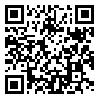Volume 20, Issue 4 (Winter 2026)
Salmand: Iranian Journal of Ageing 2026, 20(4): 610-623 |
Back to browse issues page
Download citation:
BibTeX | RIS | EndNote | Medlars | ProCite | Reference Manager | RefWorks
Send citation to:



BibTeX | RIS | EndNote | Medlars | ProCite | Reference Manager | RefWorks
Send citation to:
Babaei Z, Yadegari F, Vahedi M. Relationship of Aphasia Severity With Quality of Life in Home-dwelling Elderly With Stroke-induced Aphasia in Iran. Salmand: Iranian Journal of Ageing 2026; 20 (4) :610-623
URL: http://salmandj.uswr.ac.ir/article-1-2979-en.html
URL: http://salmandj.uswr.ac.ir/article-1-2979-en.html
1- Department of Speech Therapy, Faculty of Rehabilitation Sciences, University of Social Welfare and Rehabilitation Sciences, Tehran, Iran. & Department of Speech Therapy, Faculty of Rehabilitation Sciences, Babol University of Medical Sciences, Babol, Iran.
2- Department of Speech Therapy, Faculty of Rehabilitation Sciences, University of Social Welfare and Rehabilitation Sciences, Tehran, Iran. ,fa.yadegari@uswr.ac.ir
3- Substance Abuse and Dependence Research Center, University of Social Welfare and Rehabilitation Sciences, Tehran, Iran. & Department of Epidemiology and Biostatistics, Faculty of Social Health, University of Social Welfare and Rehabilitation Sciences, Tehran, Iran.
2- Department of Speech Therapy, Faculty of Rehabilitation Sciences, University of Social Welfare and Rehabilitation Sciences, Tehran, Iran. ,
3- Substance Abuse and Dependence Research Center, University of Social Welfare and Rehabilitation Sciences, Tehran, Iran. & Department of Epidemiology and Biostatistics, Faculty of Social Health, University of Social Welfare and Rehabilitation Sciences, Tehran, Iran.
Abstract: (1699 Views)
Objectives Natural aging is accompanied by declines in physical, sensory, psychomotor, and cognitive domains. When these declines occur along with stroke-induced aphasia, it can significantly affect an individual’s quality of life (QoL). This study aimed to examine the relationship of aphasia severity with QoL in Iranian older adults with stroke-induced aphasia.
Methods & Materials This correlational study with a cross-sectional design was conducted in 2022-2023 on 56 Persian-speaking people aged 60 and older diagnosed with aphasia, classified into three severity levels: Mild (n=21), moderate (n=14), and severe (n=21) using the clinical screening version of the Persian diagnostic aphasia battery (P-DAB-1). Participants were mainly selected from Tehran city, with a small number from Shiraz, Kerman, and Amol cities using a non-probability sampling method. Subsequently, the Stroke and Aphasia QoL scale (SAQOL-39) was completed by the participants. To analyze the data, descriptive statistics (Mean±SD), one-way ANOVA followed by Tukey’s post-hoc test, ANCOVA (for controlling the effects of age groups and time post-stroke), and Pearson’s correlation test in SPSS software, version 26, with a significance level set at 0.05.
Results Participants were 30 men and 26 women, with a mean age of 68.61 years and a mean post-stroke time of 18.30 months. Significant differences were observed between severe and mild aphasia groups in the total SAQOL-39 score and its communication domain, and between moderate and severe aphasia groups in the physical domain (P<0.05). No significant differences were noted in the psychosocial and energy domains (P>0.05). Age (P=0.466) and time post-stroke (P=0.209) showed no significant impact on QoL. The total SAQOL-39 score (r=0.37) and its domains of communication (r=0.51), psychosocial (r=0.36), physical (r=0.23), and energy (r=0.23) had a significant correlation with aphasia severity (P<0.001).
Conclusion As the severity of aphasia increases, the QoL of Iranian older people with stroke-induced aphasia declines. These findings underscore the importance of considering aphasia severity in evaluating the QoL of older adults in Iran, and can be useful for therapeutic and supportive interventions.
Methods & Materials This correlational study with a cross-sectional design was conducted in 2022-2023 on 56 Persian-speaking people aged 60 and older diagnosed with aphasia, classified into three severity levels: Mild (n=21), moderate (n=14), and severe (n=21) using the clinical screening version of the Persian diagnostic aphasia battery (P-DAB-1). Participants were mainly selected from Tehran city, with a small number from Shiraz, Kerman, and Amol cities using a non-probability sampling method. Subsequently, the Stroke and Aphasia QoL scale (SAQOL-39) was completed by the participants. To analyze the data, descriptive statistics (Mean±SD), one-way ANOVA followed by Tukey’s post-hoc test, ANCOVA (for controlling the effects of age groups and time post-stroke), and Pearson’s correlation test in SPSS software, version 26, with a significance level set at 0.05.
Results Participants were 30 men and 26 women, with a mean age of 68.61 years and a mean post-stroke time of 18.30 months. Significant differences were observed between severe and mild aphasia groups in the total SAQOL-39 score and its communication domain, and between moderate and severe aphasia groups in the physical domain (P<0.05). No significant differences were noted in the psychosocial and energy domains (P>0.05). Age (P=0.466) and time post-stroke (P=0.209) showed no significant impact on QoL. The total SAQOL-39 score (r=0.37) and its domains of communication (r=0.51), psychosocial (r=0.36), physical (r=0.23), and energy (r=0.23) had a significant correlation with aphasia severity (P<0.001).
Conclusion As the severity of aphasia increases, the QoL of Iranian older people with stroke-induced aphasia declines. These findings underscore the importance of considering aphasia severity in evaluating the QoL of older adults in Iran, and can be useful for therapeutic and supportive interventions.
Type of Study: Research |
Subject:
Speech therapy
Received: 2024/11/26 | Accepted: 2025/01/13 | Published: 2026/03/01
Received: 2024/11/26 | Accepted: 2025/01/13 | Published: 2026/03/01
Send email to the article author
| Rights and permissions | |
 |
This work is licensed under a Creative Commons Attribution-NonCommercial 4.0 International License. |








